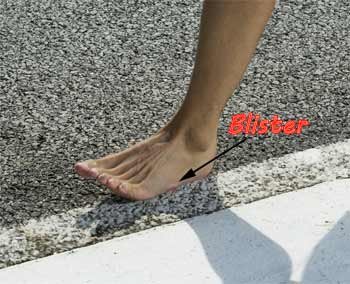Blister Treatment for Marathoners
Blisters and running go hand-in-hand. Or, is that foot-in-foot? Puns aside, blisters can be excruciating. Blisters form on the bottoms and side of the feet and toes, and between the toes. Tight-laced shoes can also cause blisters to form on the top of the feet.

Blisters are caused by friction and exacerbated by moisture. There are two basic types of blisters, one that's popped and one that hasn't. "What's the difference?", you might say. A regular, un-popped blister forms a bubble of fluid swelling. The bubble can provide cushioning against wear and somewhat reduce the pain, unless the swelling is large and causes a lot of pressure. On the flip side, a popped blister does not have that cushion, has torn skin, and is susceptible to infection.
Marathon runners must deal with blisters. It's a simple fact of the sport. The key is to minimize their occurence and to handle them appropriately when they form.
Minimizing Blisters
Well-fitting, broken-in shoes are the most important factor in minimizing blisters. It also helps to have built up calluses (by doing a good training schedule), as these will help resist any friction.
Try to keep your feet dry, moisture makes the skin soft. Wearing wicking socks, as opposed to normal cotton socks, will help wick away foot sweat. You can also put anti-persperant on your feet to help reduce the amount of sweat they produce.
Treating and Running with Blisters
Sometimes you'll have to run on blisters. You might have the toughest feet on the planet, have prepared with broken-in shoes and excellent wicking socks, and you can still get blisters. Blisters that happen while you're running won't kill you. But they may feel like they're going to. Feet contain a lot of nerves and are sensitive, and that's why even small blisters can be very painful.
You can either do nothing and grit out the pain, or treat the blisters during the race. Treatment involves lubricating and/or covering the blistered area. For unpopped blisters, a lubricant like Vaseline or Dr. Scholl's Blister Defense will help reduce the friction to the area, lessening the pain.
You can also cover the blister with a liquid bandage product like New Skin or 2nd Skin. This works well for blisters that have popped. This involves placing a moleskin like material over the blister and gluing it to your skin. This artificial skin will immediately help to reduce friction and repair the integrity of the broken skin.
Top Blister Prevention and Treatment Products
Spenco 2nd Skin Dr. Scholl's Blister Defense Book: Fixing Your Feet
Sometimes blisters are too large to cover with a liquid bandage, such as large areas on the bottom of the feet. Some runners have had these blisters covering nearly the entire bottom of their foot! The pain in these areas can be overwhelming.
To stay in the run, many runners turn to taping these blister monsters. Athletic tape is an option, but it won't hold up for many miles. A more durable, but difficult to remove option, is duct tape. Yes, duct tape! Wrapped just a bit loosely (so as to not restrict foot movement) around the foot and blistered area can save a runner from more damage. Before applying any tape, you'll need to make sure the foot is as dry as possible. Your foot will sweat, so wrapping around the foot is necessary for the tape to hold. If you have some anti-persperant available, put this on the area prior to wrapping it. That'll help keep moisture from collecting under the tape.
Dealing with blisters as early as possible will mitigate larger problems. In training runs, it's a good idea to take care of them as quickly as possible. You don't want a blister to become infected and become a big problem.
If you start to feel a hot spot in a marathon, you'll have to figure out if you want to invest the few minutes to repair it, or just tough it through. If you are prone to blisters, carrying a small repair kit is a good idea. Medical stations along the route will also have blister repair materials.
Good luck and keep those feet happy and healthy!






